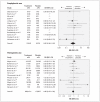Use of recombinant factor VIIa for the prevention and treatment of bleeding in patients without hemophilia: a systematic review and meta-analysis
- PMID: 21078742
- PMCID: PMC3017272
- DOI: 10.1503/cmaj.100408
Use of recombinant factor VIIa for the prevention and treatment of bleeding in patients without hemophilia: a systematic review and meta-analysis
Abstract
Background: The benefits and risks of off-label use of recombinant factor VIIa in patients without hemophilia are contested. We performed a systematic review to assess the effectiveness and safety of such use.
Methods: We searched electronic databases including MEDLINE, EMBASE and CENTRAL for randomized controlled trials comparing recombinant factor VIIa with placebo in any patient population except those with hemophilia up to January 2010. Eligible articles were assessed for inclusion, data were extracted, and study quality was evaluated. Outcomes included mortality, blood loss, requirements for red blood cell transfusion, number of patients transfused and thromboembolic events.
Results: We identified 26 trials: 14 on off-label prophylactic use of recombinant factor VIIa (n = 1137) and 12 on off-label therapeutic use (n = 2538). In the studies on prophylactic use, we found no significant difference in mortality or thromboembolic events between the treatment and placebo groups. We found modest benefits favouring recombinant factor VIIa in blood loss (weighted mean difference -276 mL, 95% confidence interval [CI] -411 to -141 mL), red blood cell transfusion (weighted mean difference -281 mL, 95% CI -433 to -129 mL) and number of patients transfused (relative risk 0.71, 95% CI 0.50 to 0.99). In the therapeutic trials, we found a nonsignificant decrease in mortality and a nonsignificant increase in thromboembolic events but no difference in control of bleeding or red blood cell transfusion.
Interpretation: Clinically significant benefits of recombinant factor VIIa as a general hemostatic agent in patients without hemophilia remain unproven. Given its potential risks, such use cannot be recommended, and in most cases, it should be restricted to clinical trials.
Figures



Comment in
-
Off-label use of recombinant factor VIIa: why we need better drug monitoring.CMAJ. 2011 Jan 11;183(1):26-7. doi: 10.1503/cmaj.101842. CMAJ. 2011. PMID: 21220460 Free PMC article. No abstract available.
References
-
- The Haemostasis Registry — How far have we come and what do we have to show for it? Victoria (Australia): Monash University; 2008. Available: www.med.monash.edu.au/epidemiology/traumaepi/workshop09.html (accessed 2010 June 20).
-
- Stanworth SJ, Birchall J, Doree CJ, et al. Recombinant factor VIIa for the prevention and treatment of bleeding in patients without haemophilia. Cochrane Database Syst Rev 2007;(2): CD005011. - PubMed
-
- Mayer SA, Brun NC, Begtrup K, et al. Efficacy and safety of recombinant activated factor VII for acute intracerebral hemorrhage. N Engl J Med 2008;358:2127–37 - PubMed
-
- Hsia CC, Chin-Yee IH, McAlister VC. Use of recombinant activated factor VII in patients without hemophilia: a meta-analysis of randomized control trials. Ann Surg 2008;248:61–8 - PubMed
-
- Diringer MN, Skolnick BE, Mayer SA, et al. Risk of thromboembolic events in controlled trials of rFVIIa in spontaneous intracerebral hemorrhage. Stroke 2008;39:850–6 - PubMed
Publication types
MeSH terms
Substances
LinkOut - more resources
Full Text Sources
Medical
